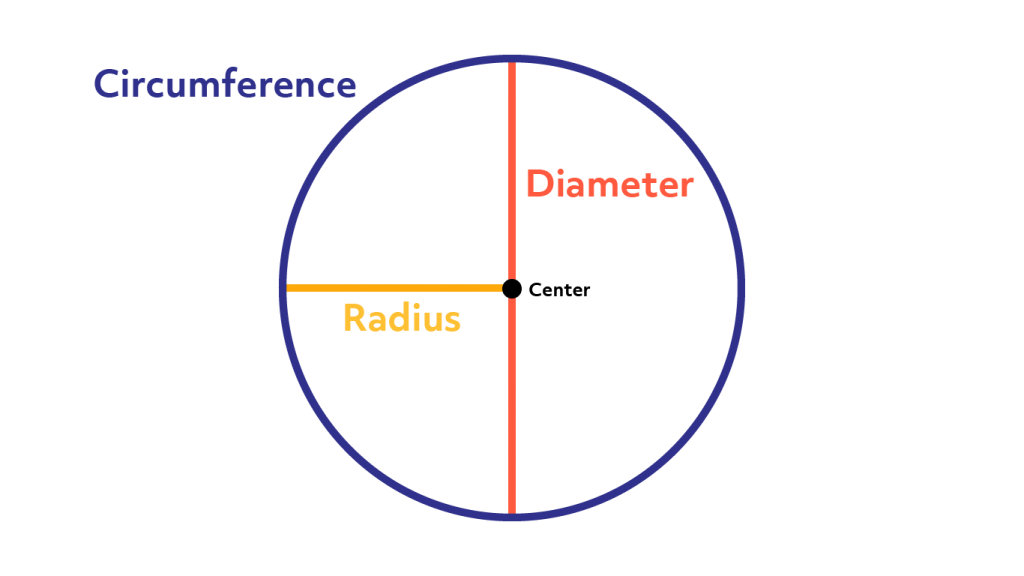As with triangles and rectangles, we can attempt to derive formulas for the area and "perimeter" of a circle. Calculating the circumference of a circle is not as easy as calculating the perimeter of a rectangle or triangle, however. A circle is a geometric form of which every point on the outside of the circle is the same distance away from the center. The distance around the edge of the circle is called the circumference. The distance from one side of the circle to the other, going through the center of the circle, is the diameter.
The constant pi, designated by the Greek letter π, is the ratio of the circumference to the diameter of a circle. For any circle, if you divide the circumference by the diameter you get pi, an irregular number usually rounded to 3.14. The learning outcome of this article is that one can calculate the circumference of circular objects and circular paths.
The circumference of a circle of radius $r$ is $2\pi r$. This well known formula is taken up here from the point of view of similarity. It is important to note in this task that the definition of $\pi$ already involves the circumference of a circle, a particular circle. In order to show that the ratio of circumference to diameter does not depend on the size of the circle, a similarity argument is required. Two different approaches are provided, one using the fact that all circles are similar and a second using similar triangles.
This former approach is simpler but the latter has the advantage of leading into an argument for calculating the area of a circle. To understand how to calculate circumference we must first begin with the definition of circumference. Circumference of a circle is linear distance around outer border of a circle. To find out the circumference, we need to know its diameter which is the length of its widest part.
The diameter should be measured in feet for square footage calculations and if needed, converted to inches , yards , centimetres , millimetres and metres . The formula for the circumference of a circle in terms of its radius comes from the definition of the constant . The constant is defined as the ratio of any circles circumference divided by its diameter. Use the circle circumference formula to calculate the circumference of the following circles.
The circumference of a circle is the measurement around a circle's edge. It can be compared to finding the perimeter of a shape . If you were to cut a circle and lay the outline flat, the length of the line it created would be its circumference.
The circumference can be measured in any unit or system that traditionally measures length - imperial (inches, feet, etc.) or metric (centimeters, meters, etc.). Whichever unit the radius is measured in will also be the unit the circumference is calculated in. Two formulas are used to find circumference, C, depending on the given information.
Both circumference formulas use the irrational number Pi, which is symbolized with the Greek letter, π. Pi is a mathematical constant and it is also the ratio of the circumference of a circle to the diameter. The distance from the centre to the outer line of the circle is called a radius. It is the most important quantity of the circle based on which formulas for the area and circumference of the circle are derived. Twice the radius of a circle is called the diameter of the circle. The diameter cuts the circle into two equal parts, which is called a semi-circle.
Circumference refers to the distance around a circle. It is a one-dimensional measurement of any two-dimensional circular surface's boundary. When the formula for calculating the circumference of a circle is used, the circle's radius is considered. As a result, the radius or diameter value must be known to calculate the circle's perimeter or circumference.
The first solution requires a general understanding of similarity of shapes while the second requires knowledge of similarity specific to triangles. Once again in this example, we're given the radius of the circle. Although it's not a clean number like our previous example, but we can still simply plug the number directly into the formula like what we did above. Be aware of the units that this circle's radius is given in and remember to give your final answer in the same unit. In this question, we find that the circumference is equalled to 53.41m.
The radius, the diameter, and the circumference are the three defining aspects of every circle. Given the radius or diameter and pi you can calculate the circumference. The diameter is the distance from one side of the circle to the other at its widest points. The diameter will always pass through the center of the circle.
You can also think of the radius as the distance between the center of the circle and its edge. Although the circumference of a circle is the length of its boundary, it cannot be calculated with the help of a ruler like it is usually done for other polygons. Therefore, to calculate the circumference of a circle, we apply a formula that uses the radius or the diameter of the circle and the value of Pi (π). This is how we calculate the circumference of a circle and understand its difference from the area. It is a one-dimensional physical quantity that can be easily understood and calculated if we follow how the formula is determined. Focus on the solved examples and start using the formula to understand the concept better.
A circle is a closed round shape with all the points equidistant from a fixed point known as the centre. The circle's circumference is measured in length units such as metres and centimetres. Does calculating circumference have you running in circles? Our circumference calculator is an easy way for you to find the circumference of any circular object. You can think of it as the line that defines the shape.
For shapes made of straight edges this line is called theperimeter but for circles this defining line is called the circumference. The perimeter of a circle is the same as the circumference of a circle. It is the total length of the outer boundary of the circle.
The perimeter or circumference of a circle is the product of the constant 'pi' and the diameter of the circle. It is expressed in linear units like m, inch, cms, feet. When we use the formula to calculate the circumference of the circle, then the radius of the circle is taken into account. Hence, we need to know the value of the radius or the diameter to evaluate the perimeter of the circle.
A circle known to us is described as a form where all the locations are equidistant from a point at the centre. The definition of the circumference of a circle in mathematics is the distance around the circle. It is the 1D linear estimation of the boundary across any two-dimensional circular surface. The diameter of a circle is twice to that of the radius. If the diameter or radius of a circle is given, then we can easily find the circumference.
We can also find the diameter and radius of a circle if the circumference is given. We round off to 3.14 in order to simplify our calculations. Circumference, diameter and radii are calculated in linear units, such as inches and centimeters.
A circle has many different radii and many different diameters, and each one passes through the center. Not just this but there are some significant distances on a circle that needs to be calculated before finding the circumference of the circle. Diameter is the distance from one side of the circle to the other, crossing through the center/ middle of the circle. It looks like you calculated the area of a circle using a radius of 2; in this figure, the radius of each circle is 1. To find the area of the figure, imagine the two semi-circles are put together to create one circle. Then calculate the area of the circle and add it to the area of the square.
Now that you know how to calculate the circumference and area of a circle, you can use this knowledge to find the perimeter and area of composite figures. The diameter of any circle is two times the length of that circle's radius. The Greek letter p (pronounced as "pie") is used to describe this number. It stands for the ratio between the circumference of any circle and its diameter, and it's true for all circles. This means that any circle's circumference will be about 3.14 times the length of its diameter. Along the way, you also learned a little geography and history, which may also come in handy to you.
The two semi-circles that form the remainder of the perimeter, and can be considered two halves of one circle. The circumference of the circle would account for the outer edges of the two semi-circles in the ice rink. Find the circumference of the circle with the formula as follows. Pi is a constant value used for the measurement of the area and circumference of a circle or other circular figures. The symbol of pi is π and its numeric value is equal to 22/7 or 3.14.
Further, these numeric values are used based on the context of the equation. The circumference of a circle is defined as the linear distance around it. In other words, if a circle is opened to form a straight line, then the length of that line will be the circle's circumference. Pi (π) is a special mathematical constant; it is the ratio of circumference to diameter of any circle. Circumference of a circle" or "Perimeter of circle" with its definition, formula, methods to find the circle's circumference with many solved examples.
One can also find the area of a circle if the circumference is given. For this first, we have to divide the circumference by π and then by 2. Then put the radius in the area formula to calculate the area. From the area to get the radius, we should first divide by π and then find the square root of it. Next simply, put the value of the radius in the formula for circumference to find the circumference. The circle's radius is also taken into account to find the circle's circumference.
Thus, to calculate the perimeter of a circle, we must first determine the radius or diameter of that circle. For example, the length of a 180 degree arc must be half the circumference of the circle, the product of pi and the radius. The length of any arc is equal to whatever fraction of a full rotation the arc spans multiplied by the circumference of the circle. A 45 degree arc, for example, spans one-eighth of a full rotation, and is therefore equal to one-eighth the circumference of that circle. The length of an arc of n degrees equals (n/360) times the circumference.
Thus, we can calculate the circumference of a circle if we know the circle's radius . For most calculations that require a decimal answer, estimating π as 3.14 is often sufficient. For instance, if a circle has a radius of 3 meters, then its circumference C is the following. Try the free Mathway calculator and problem solver below to practice various math topics. Try the given examples, or type in your own problem and check your answer with the step-by-step explanations.
If you know the circumference, radius, or diameter of a circle, you can also find its area. Area represents the space enclosed within a circle. It's given in units of distance squared, such as cm2 or m2.
This first argument is an example of MP7, Look For and Make Use of Structure. The key to this argument is identifying that all circles are similar and then applying the meaning of similarity to the circumference. The second argument exemplifies MP8, Look For and Express Regularity in Repeated Reasoning.
What Is The Formula For Area Of Circle With Diameter Here the key is to compare the circle to a more familiar shape, the triangle. As stated before, the perimeter or circumference of a circle is the distance around a circle or any circular shape. The circumference of a circle is the same as the length of a straight line folded or bent to make the circle. The circumference of a circle is measured in meters, kilometers, yards, inches, etc. The distance around a polygon, such as a square or a rectangle, is called the perimeter .
On the other hand, the distance around a circle is referred to as the circumference . Therefore, the circumference of a circle is the linear distance of an edge of the circle. The distance around a rectangle or a square is as you might remember called the perimeter. The distance around a circle on the other hand is called the circumference . Lauren is planning her trip to London, and she wants to take a ride on the famous ferris wheel called the London Eye. While researching facts about the giant ferris wheel, she learns that the radius of the circle measures approximately 68 meters.
What is the approximate circumference of the ferris wheel? Now to practice, try drawing a circle on a piece of paper, and measure your diameter with a ruler. Understanding what a circumference of a circle is and how to calculate it is crucial as you move to higher level math. In this article you will learn the answers to the following questions.
The diameter of the circle is the longest chord that passes through the center of the circle. The circumference of the circle is the length of the outer boundary of the circle. Both the diameter and the circumference are lengths and are expressed in linear units. The circumference of the circle is equal to the product of the diameter and the constant π . The circumference of a circle is the perimeter of the circle. It is the total length of the boundary of the circle.

















































